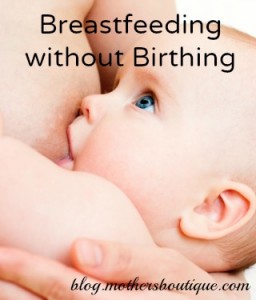Christine Barker was still nursing her third biological child, a toddler, when her family began looking to adopt a fourth child. Barker had had no issues nursing her first three children and was serving as a La Leche League leader. She felt well-informed, committed to breastfeeding, and it never occurred to her that her milk supply would not adjust to meet the needs of an adopted newborn.
Her family got a call to bring home baby Anna at 6 days old, a baby who was withdrawing from drugs and alcohol and had a lot of challenges. She was a fussy baby, needing a lot of extra love and nurturing. Exhausted, Barker discovered that her supply was not increasing to meet Anna’s  nutritional needs. She realized she needed to change her plan.
nutritional needs. She realized she needed to change her plan.
In an effort to keep Anna at the breast, Barker tried a LactAid nursing trainer, but Anna balked at the tubing. Despite many efforts to nurse her through nipple shields, baby Anna refused anything except the bare breast, and Barker was not producing enough milk to meet Anna’s nutritional needs.
At that point, Barker made the decision to feed Anna bottles of artificial baby milk while still offering the breast for comfort. “It was nice,” says Barker of offering the breast, even for non-nutritive needs. “That was a way to really help me bond with Anna.” This solution worked well and Anna was able to comfort nurse until she was two and a half years old, when she gradually weaned. “She just kind of stopped asking to nurse,” Barker says. “It was nothing I was actively trying.”
Four years later, the Barkers decided to add a fifth child to their family and looked to adopt again. The agency they worked with gave them an estimated wait time of 9 months for a baby, and this gave Barker enough time to research her options for induced lactation. She began following the Newman Goldfarb induced lactation protocol, taking a high-estrogen birth control pill (Yasmin) for six months and ordering Domperidome online, taking this medication to increase her prolactin levels.
Barker started pumping a few months before getting the call for her fifth baby, getting 5 ounces per day across several sessions. “In the last month, I even started waking once at night to pump and stimulate that supply,” she says.
The family got a call about a baby one weekend, but the adoption fell through. Barker kept pumping through this emotional time and Wednesday evening, her caseworker called to let her know about a baby girl who’d just been born. The baby’s parents were both mentally disabled, and medical staff suspected the baby would have special needs as well. Barker realized all four of her other children were born on a Wednesday. It felt serendipitous that she got this call right after another opportunity fell through and they welcomed their newest daughter, baby Wednesday Barker, into their home 8 days later.
Even though Barker had built up a full supply of milk for Wednesday, the tiny, 5-pound baby had no suck reflex. Nursing proved extremely challenging. Working closely with several lactation consultants, Barker tried both the LactAid Nursing Trainer and the Supplemental Nursing System. She spent hours working to improve Wednesday’s suck reflex, using her finger in the roof of Wednesday’s mouth in between nursing sessions that took hours. She soon found that she spent the majority of her waking hours in a chair in her bedroom working in various ways to feed Wednesday.
This was a wrought time for Barker, because “breastfeeding is one way that I parent, one way that I bond with my children,” she says, and she felt caught off guard by the challenges she met inducing lactation for her adopted children.
“I felt really prepared to nurse Wednesday and was not expecting to have the struggle I did.”
Between the pumping sessions to maintain her supply, the needs of a newborn, and the four other young children at home, Barker came to a crossroads again. “I needed to choose something to give, and for me that was the pumping.”
Knowing this would mean the end of a full milk supply, Barker decided to wean from the Domperidone, eat oatmeal to boost her supply naturally as much as possible, and offer the breast for comfort. “Breastfeeding doesn’t have to be all or nothing,” Barker says.
By this point in her parenting journey, she had gathered a village of supportive mothers and she was able to acquire donor milk to feed Wednesday for 15 months.
The Barkers live in a small town in Connecticut and found many donors eager to give small amounts of milk, plus 5 donors who regularly provided enough milk to fill an entire chest freezer. She says, “I used to drive to Rhode Island to make a pickup from a mom who was exclusively pumping. She was getting 64 ounces per day! She pumped with the big bottles on each breast. I had to take multiple coolers.”
Barker’s advice for adoptive parents planning to induce lactation? “Go in with a goal of being flexible.” She says, “If your goal is nursing and bonding with baby through nursing, I think that’s a wonderful expectation.” She cautions against making an assumption about what your experience will be using previous nursing streaks (or lack thereof) as a gauge, because each baby is so different.
Wednesday nursed for comfort until she was 2 years old, when she gradually weaned, the same way all her siblings did. Four years after weaning, Barker laughs that she can still coax a few drops of liquid gold from her left breast.
Did you induce lactation to nurse an adopted baby? Leave us a comment to share your experience!










